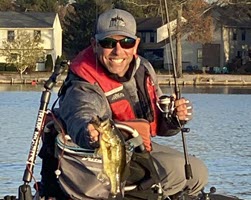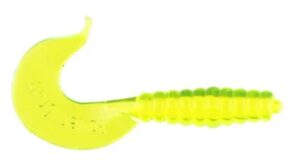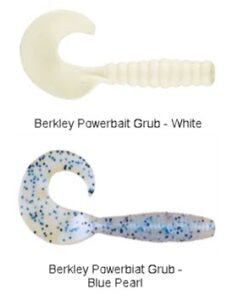
I’ve got an awesome blog for you here! I’m so pumped because we’re talking about a soft plastic lure that a lot of people have totally forgotten about. This is a lure that used to be a big deal back in the day, but now it’s kind of faded into the background. I’m talking about the grub. G-R-U-B, the grub.
Now, if you’re an older angler, let’s say 40 or older, you’re probably nodding your head right now. You know exactly what a curl tail grub is. You probably grew up fishing with it. But if you’re younger, you might be sitting there thinking, “What’s a grub?” Keep reading because I’m going to tell you what a grub is, why it’s so effective, how to rig it, and the best ways to fish it. Let’s dive in!
What is a Grub?

So first, let’s start with the basics. A grub is a soft plastic bait that’s generally about 2 to 5 inches long. It has a round, fat body and a curly tail on the back. That tail is magic! When you reel it through the water, the tail creates this rhythmic, fluttering action that fish just can’t resist. I remember fishing these as a kid with classic brands like Mister Twister and Mann’s. My favorite grub now is the Berkley Powerbait Grub! And even though swimbaits and other fancy lures have taken over, the grub still holds a special place in my tackle box.
Here’s the cool thing about a grub: it can imitate just about anything. A little baitfish? Yep. A bluegill? For sure. A crawfish creeping along the bottom? You bet! That’s what makes this lure so versatile. Plus, you can use it in any season; spring, summer, fall, and even winter when the water gets cold. It’s just a great, all-around bait.
Why Pick a Grub Over a Swimbait?
Okay, now let’s talk about the big question: why would you use a grub instead of a finesse swimbait? Look, I love swimbaits. They’re a fantastic lure when the conditions are right; clear water, tough fish, cold fronts, or high-pressure days when everyone and their brother is out fishing. That’s when a little finesse swimbait really shines.

But here’s where the Berkley Powerbait Grub comes in. What if the water is dirty or stained? What if it’s cloudy and windy, or the fish are really active and chasing bait? That’s when the grub takes over. The bigger, wider action of that curl tail can trigger strikes when swimbaits fall short. It’s especially deadly in warming water or prefrontal conditions when the fish are biting aggressively. So, don’t sleep on the Berkley Powerbait Grub! It’s got a place in your arsenal.
Picking the Right Size and Color
 Let’s get into size and color, because this is important. I carry Berkley Powerbait Grubs in a range of sizes, but my go-tos are the 3-inch and 4-inch versions. Those sizes imitate a ton of forage like small perch, bluegill, or baitfish. If the fish are eating bigger forage, like big perch or spawning bluegill, I’ll size up to a 5-inch grub. On the other hand, when the bait in the water is small, like fry or tiny minnows, I’ll go down to a 2-inch or 3-inch grub.
Let’s get into size and color, because this is important. I carry Berkley Powerbait Grubs in a range of sizes, but my go-tos are the 3-inch and 4-inch versions. Those sizes imitate a ton of forage like small perch, bluegill, or baitfish. If the fish are eating bigger forage, like big perch or spawning bluegill, I’ll size up to a 5-inch grub. On the other hand, when the bait in the water is small, like fry or tiny minnows, I’ll go down to a 2-inch or 3-inch grub.
For colors, I keep it really simple. I use white and pearl grubs when I’m trying to imitate shad or other silvery baitfish. If I’m fishing around bluegill or perch, I’ll switch to a chartreuse or something with a bright tail. And if I’m trying to mimic crawfish, I’ll use more natural, earthy tones like pumpkinseed or watermelon. That’s it, you don’t need a million colors. Match the forage, and you’ll catch fish.
How to Rig and Fish the Grub
Alright, now let’s talk about rigging. Ninety percent of the time, I’m fishing a grub on a ball head jig. This is just a simple jig head with a round weight and a hook. The key here is to use a jig head with a 90-degree line tie. That keeps the grub running perfectly horizontal, which helps the tail kick the way it’s supposed to.
When you rig the grub, you want the tail facing the opposite direction of the hook bend. So, if the hook bend is up, the curl of the tail should point down. This gives you the best action. For jig head weights, I carry everything from 1/16-ounce (for smaller grubs and shallow water) up to 3/8-ounce (for bigger grubs and deeper water). But if I had to pick one size, I’d go with a 1/4-ounce jig head. It’s super versatile.
Now, there are three main ways I fish a grub: the steady retrieve, the slow roll, and the stroking technique. The steady retrieve is the simplest, just cast it out and reel it back in. If you reel fast with your rod tip up, the grub will stay high in the water column. Lower your rod tip, and it’ll drop down to the middle. For the slow roll, let the grub hit the bottom and reel it back slowly, occasionally pausing to let it touch down again. And finally, the stroking technique, snap the rod tip to pop the grub off the bottom, then let it fall back down. This creates an irresistible jumping action.
Final Thoughts
The grub might be old school, but it still works! Whether you’re fishing stained water, active fish, or just want to throw something different, the grub is a killer choice. Grab some 2- to 5-inch Berkley Powerbait Grubs in a few key colors, rig them on a ball head jig, and try those three retrieves. I promise you’re going to catch some fish!
_________________________

______________________________________\
Like Ike on Facebook, and follow him on Instagram and TikTok for fishing and fun content.
Subscribe to Mike’s YouTube channel, to ensure you see every adventure video. (Download the YouTube app on your phone and the videos will come to you automatically.)

















